Target Information
| Target General Information | Top | |||||
|---|---|---|---|---|---|---|
| Target ID |
T79798
(Former ID: TTDC00044)
|
|||||
| Target Name |
MAP kinase p38 (MAPK12)
|
|||||
| Synonyms |
Stress-activated protein kinase 3; SAPK3; Mitogen-activated proteinkinase p38 gamma; Mitogen-activated proteinkinase 12; MAPK12; Extracellular signal-regulated kinase 6; ERK6; ERK5; ERK-6
Click to Show/Hide
|
|||||
| Gene Name |
MAPK12
|
|||||
| Target Type |
Successful target
|
[1] | ||||
| Disease | [+] 1 Target-related Diseases | + | ||||
| 1 | Thrombocytopenia [ICD-11: 3B64] | |||||
| Function |
Serine/threonine kinase which acts as an essential component of the MAP kinase signal transduction pathway. MAPK12 is one of the four p38 MAPKs which play an important role in the cascades of cellular responses evoked by extracellular stimuli such as proinflammatory cytokines or physical stress leading to direct activation of transcription factors such as ELK1 and ATF2. Accordingly, p38 MAPKs phosphorylate a broad range of proteins and it has been estimated that they may have approximately 200 to 300 substrates each. Some of the targets are downstream kinases such as MAPKAPK2, which are activated through phosphorylation and further phosphorylate additional targets. Plays a role in myoblast differentiation and also in the down-regulation of cyclin D1 in response to hypoxia in adrenal cells suggesting MAPK12 may inhibit cell proliferation while promoting differentiation. Phosphorylates DLG1. Following osmotic shock, MAPK12 in the cell nucleus increases its association with nuclear DLG1, thereby causing dissociation of DLG1-SFPQ complexes. This function is independent of its catalytic activity and could affect mRNA processing and/or gene transcription to aid cell adaptation to osmolarity changes in the environment. Regulates UV-induced checkpoint signaling and repair of UV-induced DNA damage and G2 arrest after gamma- radiation exposure. MAPK12 is involved in the regulation of SLC2A1 expression and basal glucose uptake in L6 myotubes; and negatively regulates SLC2A4 expression and contraction-mediated glucose uptake in adult skeletal muscle. C-Jun (JUN) phosphorylation is stimulated by MAPK14 and inhibited by MAPK12, leading to a distinct AP-1 regulation. MAPK12 is required for the normal kinetochore localization of PLK1, prevents chromosomal instability and supports mitotic cell viability. MAPK12-signaling is also positively regulating the expansion of transient amplifying myogenic precursor cells during muscle growth and regeneration.
Click to Show/Hide
|
|||||
| BioChemical Class |
Kinase
|
|||||
| UniProt ID | ||||||
| EC Number |
EC 2.7.11.24
|
|||||
| Sequence |
MSSPPPARSGFYRQEVTKTAWEVRAVYRDLQPVGSGAYGAVCSAVDGRTGAKVAIKKLYR
PFQSELFAKRAYRELRLLKHMRHENVIGLLDVFTPDETLDDFTDFYLVMPFMGTDLGKLM KHEKLGEDRIQFLVYQMLKGLRYIHAAGIIHRDLKPGNLAVNEDCELKILDFGLARQADS EMTGYVVTRWYRAPEVILNWMRYTQTVDIWSVGCIMAEMITGKTLFKGSDHLDQLKEIMK VTGTPPAEFVQRLQSDEAKNYMKGLPELEKKDFASILTNASPLAVNLLEKMLVLDAEQRV TAGEALAHPYFESLHDTEDEPQVQKYDDSFDDVDRTLDEWKRVTYKEVLSFKPPRQLGAR VSKETPL Click to Show/Hide
|
|||||
| 3D Structure | Click to Show 3D Structure of This Target | PDB | ||||
| HIT2.0 ID | T08RKY | |||||
| Drugs and Modes of Action | Top | |||||
|---|---|---|---|---|---|---|
| Approved Drug(s) | [+] 1 Approved Drugs | + | ||||
| 1 | SM-101 | Drug Info | Approved (orphan drug) | Idiopathic thrombocytopenic purpura | [2] | |
| Clinical Trial Drug(s) | [+] 2 Clinical Trial Drugs | + | ||||
| 1 | ARRY-797 | Drug Info | Phase 2 | Pain | [3] | |
| 2 | VX-745 | Drug Info | Phase 2 | Rheumatoid arthritis | [4], [5], [6] | |
| Mode of Action | [+] 1 Modes of Action | + | ||||
| Inhibitor | [+] 16 Inhibitor drugs | + | ||||
| 1 | SM-101 | Drug Info | [1] | |||
| 2 | ARRY-797 | Drug Info | [9] | |||
| 3 | VX-745 | Drug Info | [10], [11] | |||
| 4 | 4,5,6,7-tetrabromo-1H-benzo[d][1,2,3]triazole | Drug Info | [12] | |||
| 5 | AMP-PNP | Drug Info | [13] | |||
| 6 | Bisindolylmaleimide-I | Drug Info | [14] | |||
| 7 | CI-1040 | Drug Info | [14] | |||
| 8 | KN-62 | Drug Info | [14] | |||
| 9 | KT-5720 | Drug Info | [14] | |||
| 10 | ML-3163 | Drug Info | [15] | |||
| 11 | ML-3375 | Drug Info | [16] | |||
| 12 | Phosphonothreonine | Drug Info | [17] | |||
| 13 | RO-316233 | Drug Info | [14] | |||
| 14 | Ro31-8220 | Drug Info | [14] | |||
| 15 | RWJ-68354 | Drug Info | [18] | |||
| 16 | STAUROSPORINONE | Drug Info | [14] | |||
| Cell-based Target Expression Variations | Top | |||||
|---|---|---|---|---|---|---|
| Cell-based Target Expression Variations | ||||||
| Drug Binding Sites of Target | Top | |||||
|---|---|---|---|---|---|---|
| Ligand Name: AMP-PNP | Ligand Info | |||||
| Structure Description | PHOSPHORYLATED MAP KINASE P38-GAMMA | PDB:1CM8 | ||||
| Method | X-ray diffraction | Resolution | 2.40 Å | Mutation | Yes | [19] |
| PDB Sequence |
RSGFYRQEVT
17 KTAWEVRAVY27 RDLQPVAVCS43 AVDGRTGAKV53 AIKKLYRPFQ63 SELFAKRAYR 73 ELRLLKHMRH83 ENVIGLLDVF93 TPDETLDDFT103 DFYLVMPFMG113 TDLGKLMKHE 123 KLGEDRIQFL133 VYQMLKGLRY143 IHAAGIIHRD153 LKPGNLAVNE163 DCELKILDFG 173 LARQADSEMG184 VVTRWYRAPE195 VILNWMRYTQ205 TVDIWSVGCI215 MAEMITGKTL 225 FKGSDHLDQL235 KEIMKVTGTP245 PAEFVQRLQS255 DEAKNYMKGL265 PELEKKDFAS 275 ILTNASPLAV285 NLLEKMLVLD295 AEQRVTAGEA305 LAHPYFESLH315 QVQKYDDSRT 336 LDEWKRVTYK346 EVLSFKP
|
|||||
|
|
VAL33
4.020
ALA40
3.871
VAL41
3.537
ALA54
3.387
LYS56
2.934
ILE87
3.574
MET109
2.905
PRO110
2.797
PHE111
3.711
MET112
2.858
GLY113
4.222
|
|||||
| Ligand Name: Phosphonothreonine | Ligand Info | |||||
| Structure Description | PHOSPHORYLATED MAP KINASE P38-GAMMA | PDB:1CM8 | ||||
| Method | X-ray diffraction | Resolution | 2.40 Å | Mutation | Yes | [19] |
| PDB Sequence |
RSGFYRQEVT
17 KTAWEVRAVY27 RDLQPVAVCS43 AVDGRTGAKV53 AIKKLYRPFQ63 SELFAKRAYR 73 ELRLLKHMRH83 ENVIGLLDVF93 TPDETLDDFT103 DFYLVMPFMG113 TDLGKLMKHE 123 KLGEDRIQFL133 VYQMLKGLRY143 IHAAGIIHRD153 LKPGNLAVNE163 DCELKILDFG 173 LARQADSEMG184 VVTRWYRAPE195 VILNWMRYTQ205 TVDIWSVGCI215 MAEMITGKTL 225 FKGSDHLDQL235 KEIMKVTGTP245 PAEFVQRLQS255 DEAKNYMKGL265 PELEKKDFAS 275 ILTNASPLAV285 NLLEKMLVLD295 AEQRVTAGEA305 LAHPYFESLH315 QVQKYDDSRT 336 LDEWKRVTYK346 EVLSFKP
|
|||||
|
|
||||||
| Click to View More Binding Site Information of This Target with Different Ligands | ||||||
| Different Human System Profiles of Target | Top |
|---|---|
|
Human Similarity Proteins
of target is determined by comparing the sequence similarity of all human proteins with the target based on BLAST. The similarity proteins for a target are defined as the proteins with E-value < 0.005 and outside the protein families of the target.
A target that has fewer human similarity proteins outside its family is commonly regarded to possess a greater capacity to avoid undesired interactions and thus increase the possibility of finding successful drugs
(Brief Bioinform, 21: 649-662, 2020).
Human Tissue Distribution
of target is determined from a proteomics study that quantified more than 12,000 genes across 32 normal human tissues. Tissue Specificity (TS) score was used to define the enrichment of target across tissues.
The distribution of targets among different tissues or organs need to be taken into consideration when assessing the target druggability, as it is generally accepted that the wider the target distribution, the greater the concern over potential adverse effects
(Nat Rev Drug Discov, 20: 64-81, 2021).
Human Pathway Affiliation
of target is determined by the life-essential pathways provided on KEGG database. The target-affiliated pathways were defined based on the following two criteria (a) the pathways of the studied target should be life-essential for both healthy individuals and patients, and (b) the studied target should occupy an upstream position in the pathways and therefore had the ability to regulate biological function.
Targets involved in a fewer pathways have greater likelihood to be successfully developed, while those associated with more human pathways increase the chance of undesirable interferences with other human processes
(Pharmacol Rev, 58: 259-279, 2006).
Biological Network Descriptors
of target is determined based on a human protein-protein interactions (PPI) network consisting of 9,309 proteins and 52,713 PPIs, which were with a high confidence score of ≥ 0.95 collected from STRING database.
The network properties of targets based on protein-protein interactions (PPIs) have been widely adopted for the assessment of target’s druggability. Proteins with high node degree tend to have a high impact on network function through multiple interactions, while proteins with high betweenness centrality are regarded to be central for communication in interaction networks and regulate the flow of signaling information
(Front Pharmacol, 9, 1245, 2018;
Curr Opin Struct Biol. 44:134-142, 2017).
Human Similarity Proteins
Human Tissue Distribution
Human Pathway Affiliation
Biological Network Descriptors
|
|
|
Note:
If a protein has TS (tissue specficity) scores at least in one tissue >= 2.5, this protein is called tissue-enriched (including tissue-enriched-but-not-specific and tissue-specific). In the plots, the vertical lines are at thresholds 2.5 and 4.
|
| KEGG Pathway | Pathway ID | Affiliated Target | Pathway Map |
|---|---|---|---|
| MAPK signaling pathway | hsa04010 | Affiliated Target |

|
| Class: Environmental Information Processing => Signal transduction | Pathway Hierarchy | ||
| Rap1 signaling pathway | hsa04015 | Affiliated Target |

|
| Class: Environmental Information Processing => Signal transduction | Pathway Hierarchy | ||
| FoxO signaling pathway | hsa04068 | Affiliated Target |
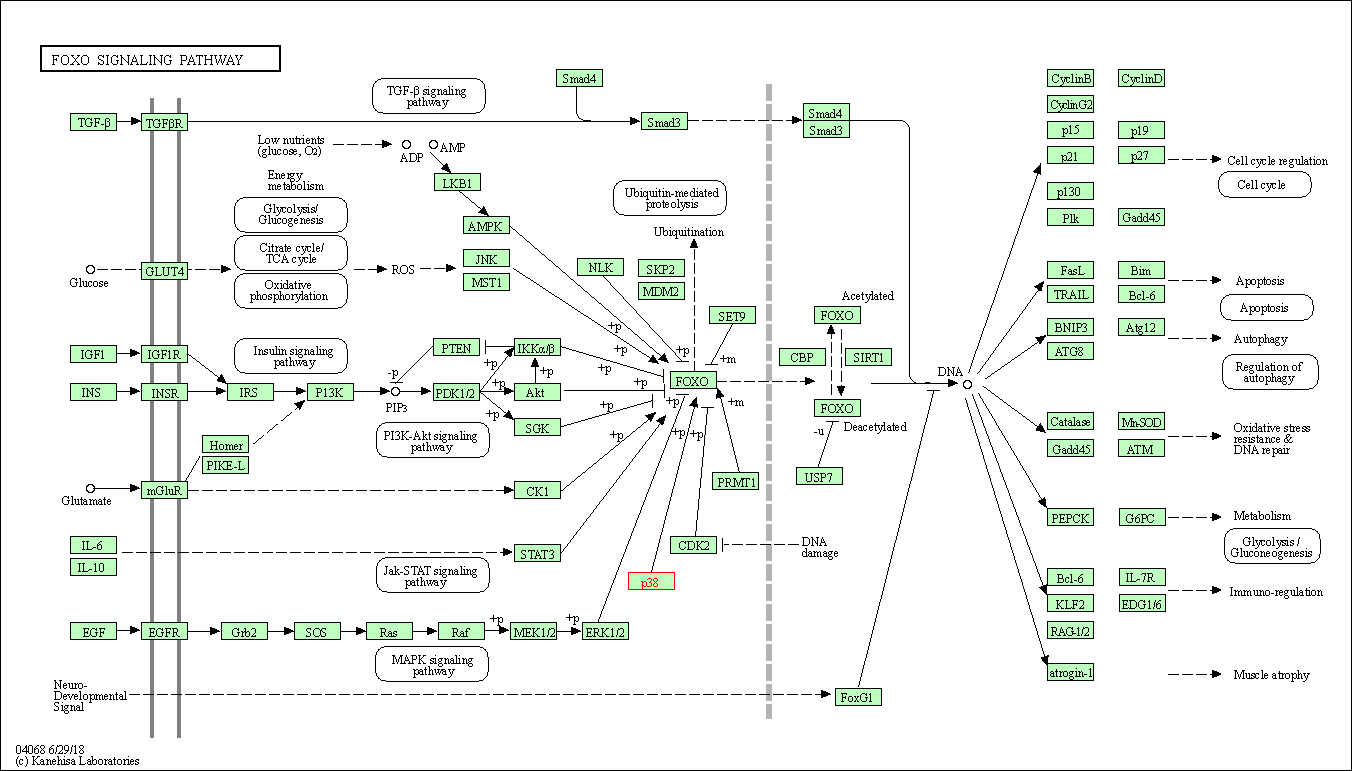
|
| Class: Environmental Information Processing => Signal transduction | Pathway Hierarchy | ||
| Sphingolipid signaling pathway | hsa04071 | Affiliated Target |

|
| Class: Environmental Information Processing => Signal transduction | Pathway Hierarchy | ||
| Oocyte meiosis | hsa04114 | Affiliated Target |

|
| Class: Cellular Processes => Cell growth and death | Pathway Hierarchy | ||
| Cellular senescence | hsa04218 | Affiliated Target |

|
| Class: Cellular Processes => Cell growth and death | Pathway Hierarchy | ||
| Adrenergic signaling in cardiomyocytes | hsa04261 | Affiliated Target |

|
| Class: Organismal Systems => Circulatory system | Pathway Hierarchy | ||
| VEGF signaling pathway | hsa04370 | Affiliated Target |

|
| Class: Environmental Information Processing => Signal transduction | Pathway Hierarchy | ||
| Osteoclast differentiation | hsa04380 | Affiliated Target |

|
| Class: Organismal Systems => Development and regeneration | Pathway Hierarchy | ||
| Signaling pathways regulating pluripotency of stem cells | hsa04550 | Affiliated Target |

|
| Class: Cellular Processes => Cellular community - eukaryotes | Pathway Hierarchy | ||
| Platelet activation | hsa04611 | Affiliated Target |

|
| Class: Organismal Systems => Immune system | Pathway Hierarchy | ||
| Neutrophil extracellular trap formation | hsa04613 | Affiliated Target |
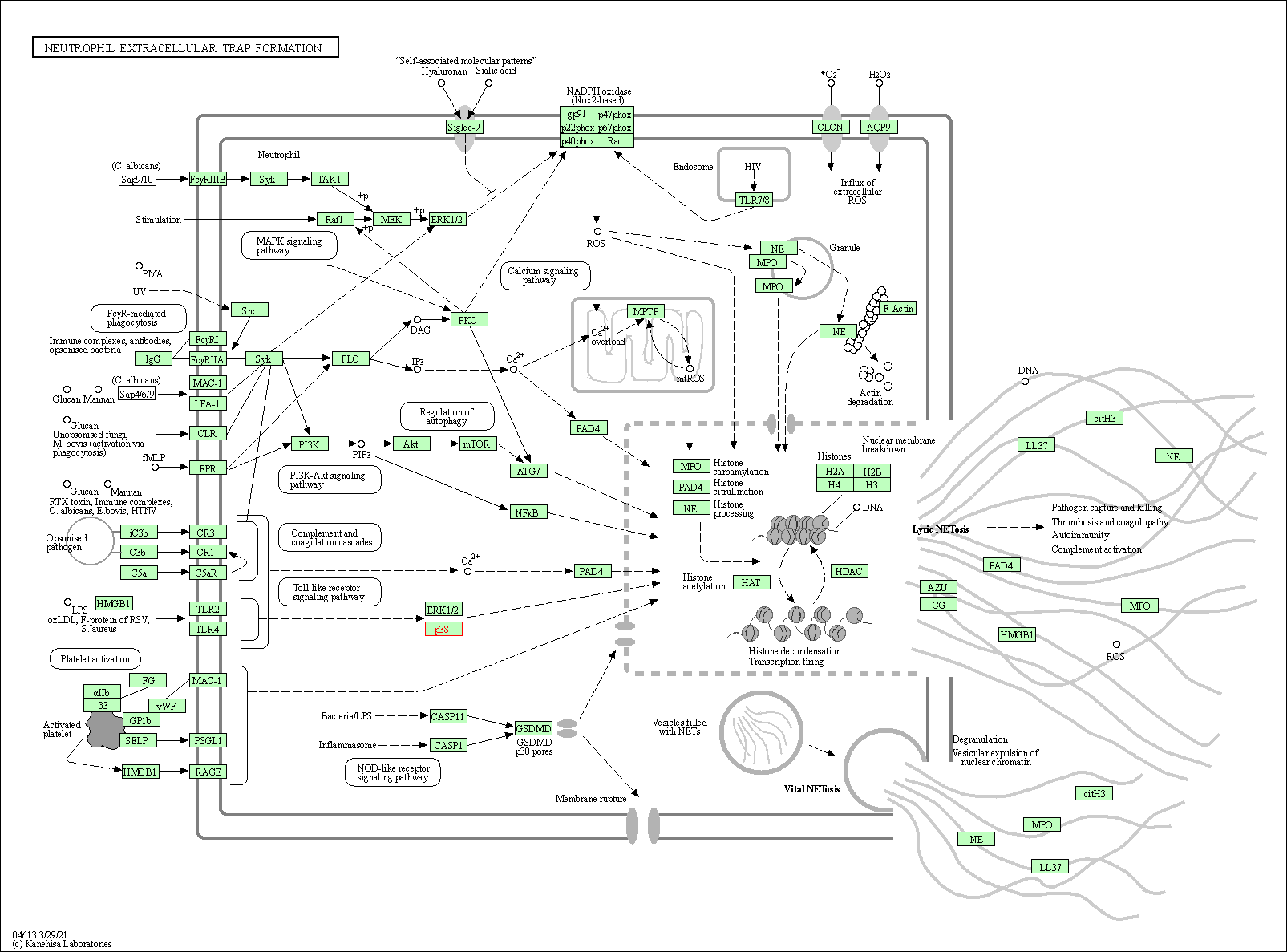
|
| Class: Organismal Systems => Immune system | Pathway Hierarchy | ||
| Toll-like receptor signaling pathway | hsa04620 | Affiliated Target |

|
| Class: Organismal Systems => Immune system | Pathway Hierarchy | ||
| NOD-like receptor signaling pathway | hsa04621 | Affiliated Target |

|
| Class: Organismal Systems => Immune system | Pathway Hierarchy | ||
| RIG-I-like receptor signaling pathway | hsa04622 | Affiliated Target |

|
| Class: Organismal Systems => Immune system | Pathway Hierarchy | ||
| C-type lectin receptor signaling pathway | hsa04625 | Affiliated Target |

|
| Class: Organismal Systems => Immune system | Pathway Hierarchy | ||
| IL-17 signaling pathway | hsa04657 | Affiliated Target |
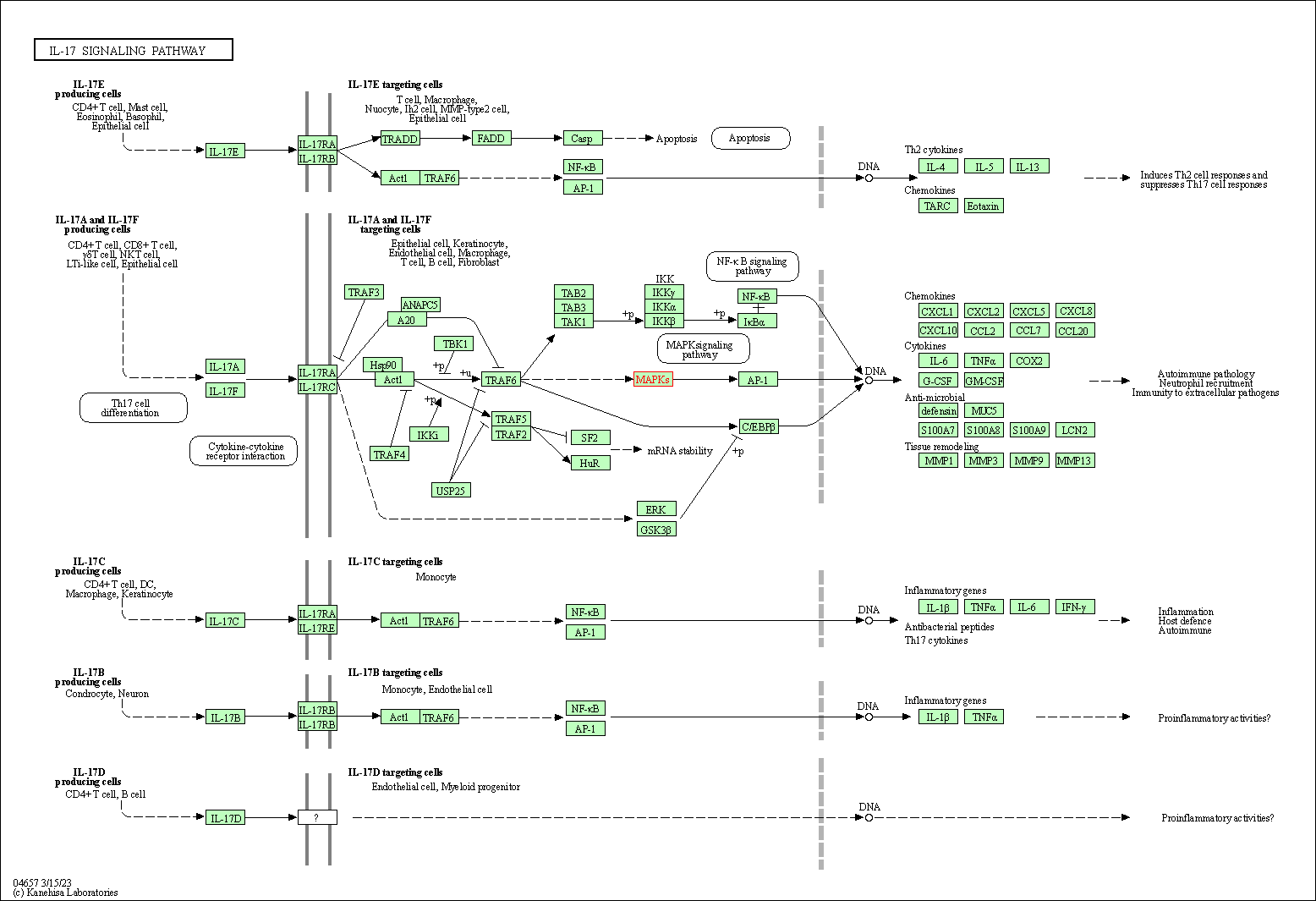
|
| Class: Organismal Systems => Immune system | Pathway Hierarchy | ||
| Th1 and Th2 cell differentiation | hsa04658 | Affiliated Target |

|
| Class: Organismal Systems => Immune system | Pathway Hierarchy | ||
| Th17 cell differentiation | hsa04659 | Affiliated Target |

|
| Class: Organismal Systems => Immune system | Pathway Hierarchy | ||
| T cell receptor signaling pathway | hsa04660 | Affiliated Target |

|
| Class: Organismal Systems => Immune system | Pathway Hierarchy | ||
| Fc epsilon RI signaling pathway | hsa04664 | Affiliated Target |

|
| Class: Organismal Systems => Immune system | Pathway Hierarchy | ||
| TNF signaling pathway | hsa04668 | Affiliated Target |

|
| Class: Environmental Information Processing => Signal transduction | Pathway Hierarchy | ||
| Leukocyte transendothelial migration | hsa04670 | Affiliated Target |

|
| Class: Organismal Systems => Immune system | Pathway Hierarchy | ||
| Thermogenesis | hsa04714 | Affiliated Target |

|
| Class: Organismal Systems => Environmental adaptation | Pathway Hierarchy | ||
| Neurotrophin signaling pathway | hsa04722 | Affiliated Target |
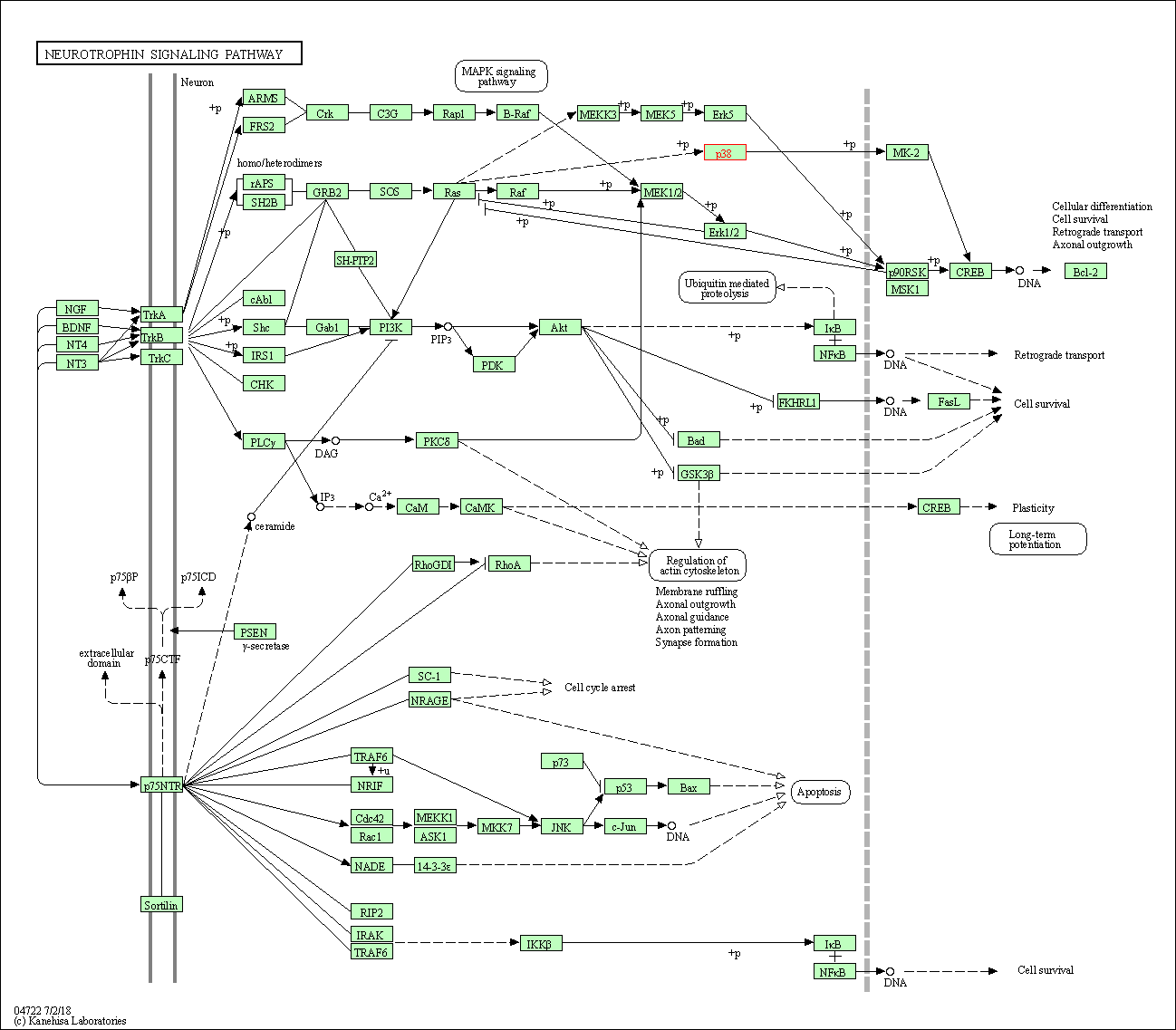
|
| Class: Organismal Systems => Nervous system | Pathway Hierarchy | ||
| Retrograde endocannabinoid signaling | hsa04723 | Affiliated Target |

|
| Class: Organismal Systems => Nervous system | Pathway Hierarchy | ||
| Dopaminergic synapse | hsa04728 | Affiliated Target |

|
| Class: Organismal Systems => Nervous system | Pathway Hierarchy | ||
| Inflammatory mediator regulation of TRP channels | hsa04750 | Affiliated Target |

|
| Class: Organismal Systems => Sensory system | Pathway Hierarchy | ||
| GnRH signaling pathway | hsa04912 | Affiliated Target |

|
| Class: Organismal Systems => Endocrine system | Pathway Hierarchy | ||
| Progesterone-mediated oocyte maturation | hsa04914 | Affiliated Target |

|
| Class: Organismal Systems => Endocrine system | Pathway Hierarchy | ||
| Prolactin signaling pathway | hsa04917 | Affiliated Target |

|
| Class: Organismal Systems => Endocrine system | Pathway Hierarchy | ||
| Relaxin signaling pathway | hsa04926 | Affiliated Target |
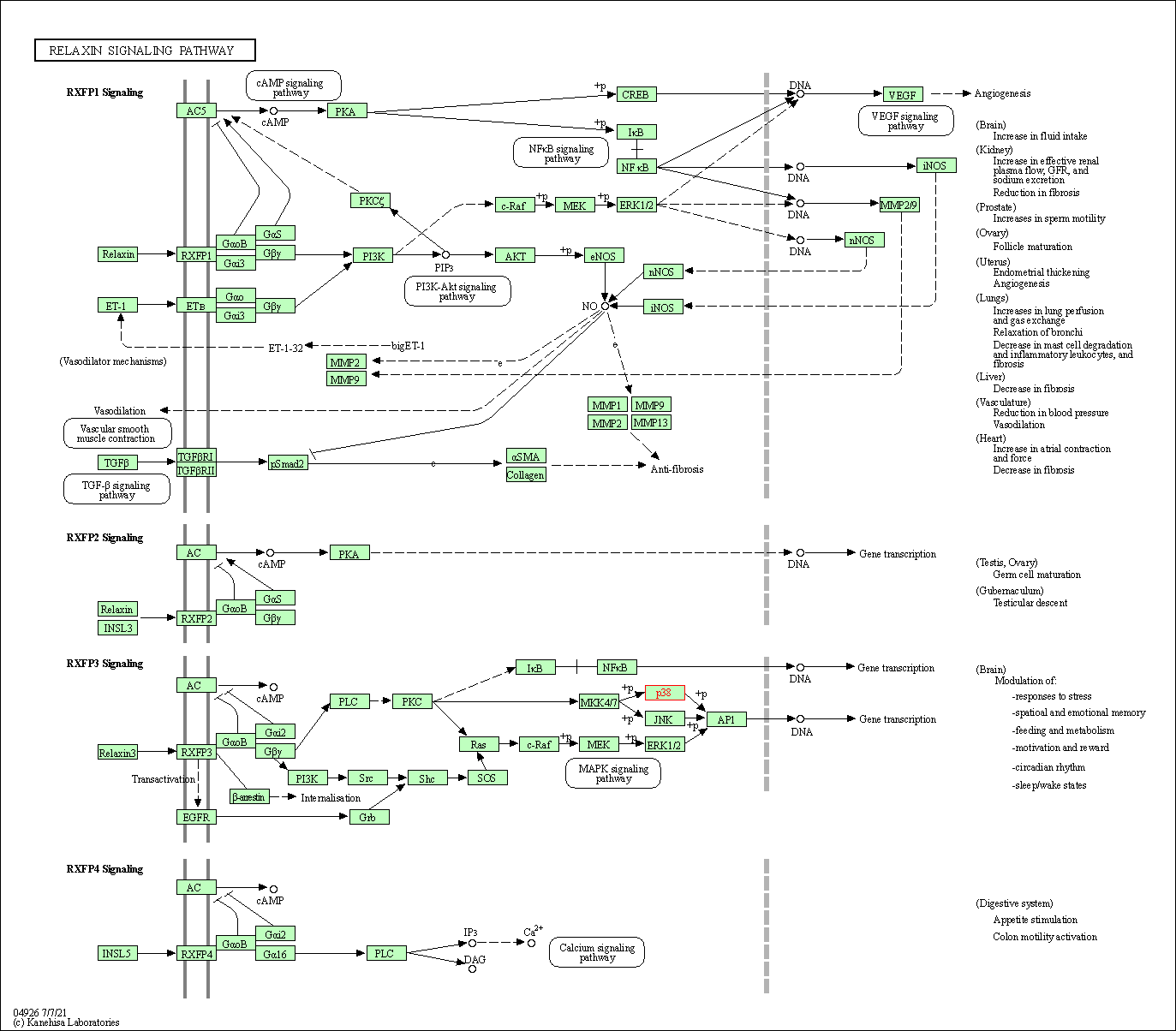
|
| Class: Organismal Systems => Endocrine system | Pathway Hierarchy | ||
| Growth hormone synthesis, secretion and action | hsa04935 | Affiliated Target |

|
| Class: Organismal Systems => Endocrine system | Pathway Hierarchy | ||
| Click to Show/Hide the Information of Affiliated Human Pathways | |||
| Degree | 12 | Degree centrality | 1.29E-03 | Betweenness centrality | 3.41E-04 |
|---|---|---|---|---|---|
| Closeness centrality | 2.26E-01 | Radiality | 1.40E+01 | Clustering coefficient | 4.55E-02 |
| Neighborhood connectivity | 2.21E+01 | Topological coefficient | 1.15E-01 | Eccentricity | 11 |
| Download | Click to Download the Full PPI Network of This Target | ||||
| Chemical Structure based Activity Landscape of Target | Top |
|---|---|
| Drug Property Profile of Target | Top | |
|---|---|---|
| (1) Molecular Weight (mw) based Drug Clustering | (2) Octanol/Water Partition Coefficient (xlogp) based Drug Clustering | |
|
|
||
| (3) Hydrogen Bond Donor Count (hbonddonor) based Drug Clustering | (4) Hydrogen Bond Acceptor Count (hbondacc) based Drug Clustering | |
|
|
||
| (5) Rotatable Bond Count (rotbonds) based Drug Clustering | (6) Topological Polar Surface Area (polararea) based Drug Clustering | |
|
|
||
| "RO5" indicates the cutoff set by lipinski's rule of five; "D123AB" colored in GREEN denotes the no violation of any cutoff in lipinski's rule of five; "D123AB" colored in PURPLE refers to the violation of only one cutoff in lipinski's rule of five; "D123AB" colored in BLACK represents the violation of more than one cutoffs in lipinski's rule of five | ||
| Co-Targets | Top | |||||
|---|---|---|---|---|---|---|
| Co-Targets | ||||||
| Target Poor or Non Binders | Top | |||||
|---|---|---|---|---|---|---|
| Target Poor or Non Binders | ||||||
| Target-Related Models and Studies | Top | |||||
|---|---|---|---|---|---|---|
| Target Validation | ||||||
| References | Top | |||||
|---|---|---|---|---|---|---|
| REF 1 | Agents in development for the treatment of diabetic nephropathy. Expert Opin Emerg Drugs. 2008 Sep;13(3):447-63. | |||||
| REF 2 | Emerging drugs for idiopathic thrombocytopenic purpura in adults. Expert Opin Emerg Drugs. 2008 Jun;13(2):237-54. | |||||
| REF 3 | Trusted, scientifically sound profiles of drug programs, clinical trials, safety reports, and company deals, written by scientists. Springer. 2015. Adis Insight (drug id 800019505) | |||||
| REF 4 | URL: http://www.guidetopharmacology.org Nucleic Acids Res. 2015 Oct 12. pii: gkv1037. The IUPHAR/BPS Guide to PHARMACOLOGY in 2016: towards curated quantitative interactions between 1300 protein targets and 6000 ligands. (Ligand id: 5719). | |||||
| REF 5 | ClinicalTrials.gov (NCT02423200) Clinical Pharmacology of p38 MAP Kinase Inhibitor, VX-745, in Mild Cognitive Impairment Due to Alzheimer's Disease (AD) or Mild AD. U.S. National Institutes of Health. | |||||
| REF 6 | Myelodysplastic Syndromes: Clinical Practice Guidelines in Oncology. J Natl Compr Canc Netw. 2011 January; 9(1): 30-56. | |||||
| REF 7 | Trusted, scientifically sound profiles of drug programs, clinical trials, safety reports, and company deals, written by scientists. Springer. 2015. Adis Insight (drug id 800023346) | |||||
| REF 8 | Trusted, scientifically sound profiles of drug programs, clinical trials, safety reports, and company deals, written by scientists. Springer. 2015. Adis Insight (drug id 800012315) | |||||
| REF 9 | Array BioPharmas ARRY-797 Meets Primary Endpoint in Clinical Proof of Concept Trial in Osteoarthritis Patients Whose Pain is Poorly Controlled by NSAIDs | |||||
| REF 10 | P38 MAP kinase inhibitors as potential therapeutics for the treatment of joint degeneration and pain associated with osteoarthritis. J Inflamm (Lond). 2008 Dec 4;5:22. | |||||
| REF 11 | Rapid synthesis of VX-745: p38 MAP kinase inhibition in Werner syndrome cells. Bioorg Med Chem Lett. 2007 Sep 15;17(18):5107-10. | |||||
| REF 12 | Optimization of protein kinase CK2 inhibitors derived from 4,5,6,7-tetrabromobenzimidazole. J Med Chem. 2004 Dec 2;47(25):6239-47. | |||||
| REF 13 | The Protein Data Bank. Nucleic Acids Res. 2000 Jan 1;28(1):235-42. | |||||
| REF 14 | Specificity and mechanism of action of some commonly used protein kinase inhibitors. Biochem J. 2000 Oct 1;351(Pt 1):95-105. | |||||
| REF 15 | From imidazoles to pyrimidines: new inhibitors of cytokine release. J Med Chem. 2002 Jun 20;45(13):2733-40. | |||||
| REF 16 | Novel substituted pyridinyl imidazoles as potent anticytokine agents with low activity against hepatic cytochrome P450 enzymes. J Med Chem. 2003 Jul 17;46(15):3230-44. | |||||
| REF 17 | How many drug targets are there Nat Rev Drug Discov. 2006 Dec;5(12):993-6. | |||||
| REF 18 | Imidazopyrimidines, potent inhibitors of p38 MAP kinase. Bioorg Med Chem Lett. 2003 Feb 10;13(3):347-50. | |||||
| REF 19 | The structure of phosphorylated p38gamma is monomeric and reveals a conserved activation-loop conformation. Structure. 1999 Sep 15;7(9):1057-65. | |||||
If You Find Any Error in Data or Bug in Web Service, Please Kindly Report It to Dr. Zhou and Dr. Zhang.

